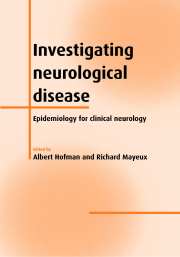Book contents
- Frontmatter
- Contents
- List of contributors
- Preface
- Part I Quantitative methods in clinical neurology
- 1 Clinical research design: analytical studies
- 2 Genetic epidemiology in neurologic disease
- 3 Gene–environment interaction in neurologic disorders
- 4 Analysis, reanalysis, and meta-analysis in neurology
- 5 Diagnostic research in clinical neurology
- 6 Decision analysis in clinical neurology
- 7 Outcomes research in clinical neurology
- 8 Survival analysis in neurological diseases
- 9 The clinical trial in efficacy research in neurological diseases
- Part II Neurological diseases
- Index
4 - Analysis, reanalysis, and meta-analysis in neurology
from Part I - Quantitative methods in clinical neurology
Published online by Cambridge University Press: 29 September 2009
- Frontmatter
- Contents
- List of contributors
- Preface
- Part I Quantitative methods in clinical neurology
- 1 Clinical research design: analytical studies
- 2 Genetic epidemiology in neurologic disease
- 3 Gene–environment interaction in neurologic disorders
- 4 Analysis, reanalysis, and meta-analysis in neurology
- 5 Diagnostic research in clinical neurology
- 6 Decision analysis in clinical neurology
- 7 Outcomes research in clinical neurology
- 8 Survival analysis in neurological diseases
- 9 The clinical trial in efficacy research in neurological diseases
- Part II Neurological diseases
- Index
Summary
Introduction
The scope of this chapter is to illustrate the problems and the methodologic issues involved in collaborative reanalyses. The theoretical discussion and the definition of terms are kept to a minimum (1,2). Emphasis is given to factual examples derived from the neurologic literature and from the personal experience of the author.
The chapter covers an example of reanalysis of descriptive epidemiologic data (e.g., incidence and prevalence studies) and an example of reanalysis of analytic epidemiologic data (e.g., case-control and cohort studies). The much more prominent application of reanalysis to experimental epidemiology (e.g., clinical trials) is not covered here. The two examples used concern Alzheimer's disease (AD) and are derived from the extensive work of the European Community Concerted Action Epidemiology and Prevention of Dementia (EURODEM) (3–6). Some of the problems and methodologic issues illustrated may refer specifically to AD and may not be generalizable to other diseases; however, the two examples should conveniently illustrate some general aspects of reanalysis.
The next few paragraphs define the terms used and explain the disagreement on the definition of meta-analysis. Analysis is the application of statistical techniques to describe the data collected or to test hypotheses on the data collected in an individual epidemiologic study. Reanalysis is the subsequent analysis of a database from which primary analyses have been reported. Reanalyses are conducted when, for example, a new hypothesis has been proposed after the initial analyses had been completed. Data from an individual study may also be reanalyzed using a different statistical approach.
The term collaborative reanalysis is used when reanalyses involve more than one database, in general with the collaboration of several investigators who conducted the initial studies.
Keywords
- Type
- Chapter
- Information
- Investigating Neurological DiseaseEpidemiology for Clinical Neurology, pp. 26 - 42Publisher: Cambridge University PressPrint publication year: 2001
- 1
- Cited by



